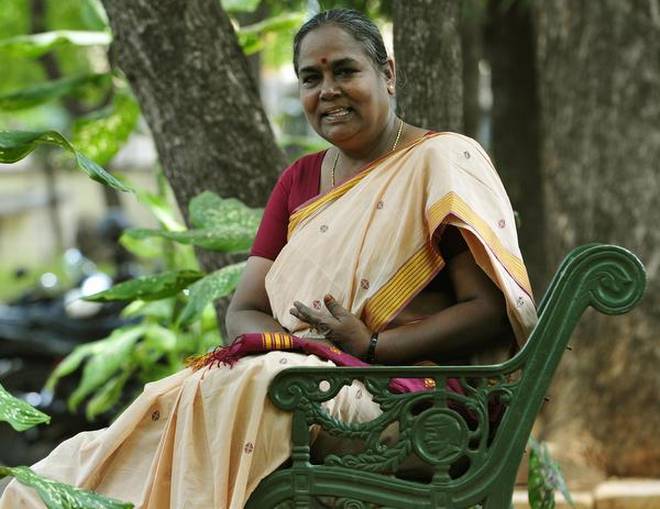Bama’s Karukku remains a trendsetter, 25 years after its publication
Long, long ago, 25 years ago, Karukku was published in Tamil by Ideas, of Madurai, in 1992. It was not a big name in literary publishing. Nor did Bama write Karukku as a literary work.
For her it was pages written in a notebook given by Fr. Mark to heal her wounds and the pain of her major decision to leave the convent. She was recovering from the trauma of having her utopia smashed. Never did anyone imagine that with Karukkua new voice in Tamil literature will start.
In full bloom
In fact, at a festival in 1993, the self-appointed ‘agmark’ literary critic Jayamohan had referred to Karukku as reportage. He still keeps spouting such comments.
What irked Bama the more was that people in her own village felt that she had written about them in “an ugly way”.Of course, the youth of Kandampatti laboured to change that opinion by reading aloud the text to the villagers. Bama was invited to her own village and felicitated.
In December 2017, Karukku’s 25th birthday celebrations were held in her village as a whole-day event with seminars, procession, dances and songs. Bama has mentioned in many places that it was the recognition she truly craved for and was gratified. Karukku is on the literature syllabi of many colleges and universities across the world today. Bama’s writings have also been dramatised. At 25, Karukku is in full bloom.
It is also important to understand that Karukku is the child of Ambedkar Centenary. As Bama said in an interview, if Karukkuwere published in the 80s, it probably would not have drawn this level of attention.
“When Karukku came out at that time, it fed that fire of social awareness,” she said. Though the works of Poomani and Imayam were already in circulation, the Tamil literary circle saw in them an extension of the social realist trend.
It is interesting to remember here that they did not wish to be classified as Dalit writers. That is primarily because Dalit discourse had not yet been brought into literary debate by the gatekeepers of Tamil literary criticism of that time.
Bama faced the brunt of it all. The tendency to discredit her literary potential died down only after Karukku was translated into English by Lakshmi Holmström. It got further validation with the awards that came its way and the many translations in different languages of the world.
Karukku defied genre classification. It was not a novel. The protagonist was not named. The story did not have a linear or non-linear structure. It had the quality of an oral narrative. It was not autobiography in the traditional sense.
It was not the story of one person. It was the story of a community. It painted the Tamil-Indian village from the perspective of the cheri, thus turning the socio-cultural geography upside down.
For those of us fed on Janakiraman and Kalki in Tamil, for the first time, the temple was not the centre of the village, and therefore, of the discourse.
Even progressive literary texts situated in rural Tamil Nadu hardly ever had the voices of women going about their everyday lives.
Bama peopled her texts with persons who were proud of their labour. They laughed, cursed, fought and cried; but were never cowed down by authority. Even the direst situation elicited at least a smirk in them.
Deceptively simple
Autobiography was not a flourishing genre in Tamil, as in the case of Marathi Dalit writing of that time. Among women’s writing in Tamil, Karukku was followed by Azhagiya Periyanayaki Ammal’s Kavalai, a documentation of the Hindu Nadar community women in the southern districts; Muthu Meenal’s Mul narrated how she won over leprosy; Muthammal Palanisamy’s Naadu vittu Naadu documented the migrant labourer’s story. So Karukku set the trend of autobiography, especially among women writing in Tamil.
Karukku challenged the time-worn tools of measuring aesthetic appeal. It forced a re-thinking of aesthetics, which is needed to make sense of this new, deceptively simple kind of writing.
Even the well-meaning, liberal readers/ critics were upset that her characters spoke obscene language in public with ease.
Again and again, Bama explained that she has captured the language of everyday life without any cosmetic facelift.
As we celebrate Karukku’s silver jubilee, Bama continues to enrich us with her compassionate reading of people. As she always says, she presents people who come her way. If that irritates or upsets readers, N.D. Rajkumar, the powerful Dalit poet, has an answer in this poem translated by Azhagarasan:
“When readers of communities other than my own
Read these…/ They will feel giddy, experience acute palpitation in the heart,
And intense, painful soreness in the eyes.
What is more, they will unlearn everything.”
source: http://www.thehindu.com / The Hindu / Home> Silver Jubilee> Lit for Life / by Mangai / January 06th, 2018
